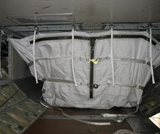Experts design bomb-proof bag for luggage compartment in planes
- Like
- Digg
- Del
- Tumblr
- VKontakte
- Buffer
- Love This
- Odnoklassniki
- Meneame
- Blogger
- Amazon
- Yahoo Mail
- Gmail
- AOL
- Newsvine
- HackerNews
- Evernote
- MySpace
- Mail.ru
- Viadeo
- Line
- Comments
- Yummly
- SMS
- Viber
- Telegram
- Subscribe
- Skype
- Facebook Messenger
- Kakao
- LiveJournal
- Yammer
- Edgar
- Fintel
- Mix
- Instapaper
- Copy Link
Posted: 24 June 2011 | University of Sheffield | 1 comment
A bag, which can protect planes from bombs in passenger luggage, has been developed…
A bag, which can protect planes from bombs in passenger luggage, has been developed by an international team of scientists, including academics from the University of Sheffield working within University spinout company Blastech Ltd.


Fundamental to the design of the bag is the internal elastomeric coating and impregnation of fabric with Shear Thickening Fluids (STF).
Elastomers are very low stiffness, high failure strain materials, often used as adhesives, sealants or in structures where high strains are expected. An elastomer was developed to provide a gas seal in the bag at very high strain rates and very high deformations, whilst resisting flame and heat.
STFs work by increasing in viscosity in response to impact. A simple STF can be made from mixing cornflour with water. Providing quantities are correct, it would be possible to roll this simple STF into a ball that will bounce on hard surfaces but return to a fluid once it is left alone.
Under normal circumstances, the particles in STFs repel each other slightly, however following sudden impact, the extra energy in the system proves stronger than the repulsive forces, causing the particles to clump together in structures called hydroclusters, which bump into each other, consequently thickening the fluid.
This unusual behaviour of STFs has already generated significant commercial interest and STFs are being considered to improve body armour designed to protect the wearer from weapons such as knives and bullets.
In the case of the Fly-Bag, the STF is coated onto the yarn of the fabric and as the fabric comes under strain, shearing forces between the yarns cause the STF to thicken, temporarily increasing the stiffness of the fabric, reducing the total deformation.
Hardened luggage containers (HULD) have been developed to deal with bombs hidden in passenger luggage, but these containers are heavier and more costly than conventional equivalents and are only suitable for wide body aircraft.
It is expected that the Fly-Bag will be on the market in one to two years, although cost would depend on a range of variables, such as the structure of the plane.
Team member Dr Jim Warren from the University of Sheffield´s Department of Civil and Structural Engineering, said: “The use of explosives on aircrafts has had a renaissance in recent years, with recent attempted attacks coming not just from passengers, but also as loaded freight. Since weight and operational flexibility is key for aircraft operators, this low weight, removable solution would seem to be a paradigm shift in the hardening of aircraft structures.”













Are you speaking about the same Fly-Bag project which was an EU FP7 project which was a great success.
However, such a container would only make sense and be a safety benefit for aviation if it would provide at the same time a high degree of fire resistance.